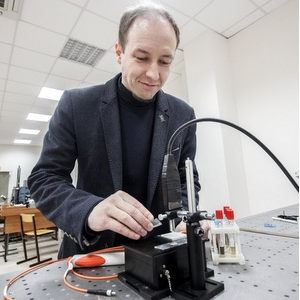Scientists from Samara University and the Institute of Electronics of the Bulgarian Academy of Sciences will jointly develop* a comprehensive method of optical non-invasive diagnostics** of benign and malignant skin neoplasms, which will bring the accuracy of detection and classification of skin pathologies to the level of 95–98%. Specialists from the Samara State Medical University (SamSMU) and the Samara Regional Clinical Oncological Dispensary (SOKOD) also take part in the research.
It is planned to create a portable device for carrying out mass and operational screening examinations of the population in polyclinics on the basis of the developed method, for example, during medical examination: to check a suspicious mole or spot on the skin, one will only need to direct a laser beam at it, after which a laptop application will diagnose quite it accurately following it built-in algorithms. It is well-known that the effectiveness of cancer treatment depends directly on its timely detection. For example, in case of detecting melanoma at its first stage, the five-year survival rate of patients after treatment is about 98% and does not exceed 15% in case melanoma was detected way into its fourth stage.
“The idea of joint research with our Bulgarian colleagues is to combine several approaches in the optical diagnosis of skin neoplasms already well-developed and well-known. Due to that combination of techniques, the diagnostic accuracy will be comprehensively increased, expectedly up to 95–98%,” said Ivan Bratchenko, Associate Professor of the Department of Laser and Biotechnical Systems at Samara University.
According to him, scientists plan to combine such types of diagnostics of skin neoplasms as Raman analysis*** (with an accuracy of determining oncopathologies at the level of 80–90%), analysis of fluorescence**** in the near infrared (accuracy about 60%) and analysis of fluorescence in the visible spectrum (accuracy about 65–80%).
The first research results of an international team of scientists were published in
Optical Engineering – an authoritative scientific journal devoted to the research, development and use of optical science and optical engineering.
The diagnostic device, which is planned to be created based on the results of the research, will be quite compact – about the size of a shoebox, and doctors will be able to take it with them, for example, when traveling to remote areas for medical examination of local residents.
“We want to create a truly portable device that can be used for mass screening examinations, that is, it will not be some kind of large laboratory facility that is difficult to transport somewhere. It will be a portable device comparable in size to a shoebox, although, of course, you will need a laptop with it, of course,” Bratchenko noted. “It is clear that in terms of a number of characteristics – the level of noise, the sensitivity of the optical signal – this device will lose out to large laboratory installations that are in large specialized clinical centers, however, the device will significantly increase the number of patients examined – on the basis of ordinary district polyclinics or on visits of doctors to remote areas. Early detection of the disease will help save lives.”
For reference
* The work is carried out within the framework of a grant received as a result of the competition for the best scientific projects of fundamental research, which was carried out jointly by the RFFR and the National Science Foundation of Bulgaria. The project will be completed in two years.
** In optical non-invasive diagnostics, optical (usually a laser) examination of the patient's tissues is taken. The analysis of the spectral data obtained in the study makes it possible to establish the biochemical changes occurring in the tissues during the development of neoplasms.
*** Raman spectroscopy is a type of spectroscopy that uses the ability of the studied molecules to Raman scattering of monochromatic light (laser radiation). Spectral lines appear in the spectrum of scattered radiation, which are absent in the spectrum of the primary (exciting) light. The number and location of the newly appeared spectral lines depends on the molecular structure of the investigated substance, which enables detecting certain changes in the tissues.
**** Fluorescence analysis is based on the fact that biological molecules are able to re-emit part of the absorbed light. The absorbed energy is released as light of a different wavelength. This phenomenon is called fluorescence.
Earlier, scientists from Samara University, SamSMU and SOKOD developed a series of devices for optical diagnostics of skin neoplasms:
an experimental setup for measuring Raman scattering, which studies the spectral characteristics of neoplasms;
a dermatoscope, which gives a visual picture of the tumor as close as possible to its surface;
a hyperspectral camera, which allows for a short time with high accuracy to make several dozen images of a tumor in different spectra.
All three devices work at the Department of Oncology of the Samara State Medical University and the SOKOD clinical base and are used in the examination of patients by oncologists. The results of the work of Samara scientists in the field of optical diagnostics of cancer are reflected in the article “Portable spectroscopic system for in vivo skin neoplasms diagnostics by Raman and autofluorescence analysis”, published in one of the most authoritative scientific journals devoted to the study of the interaction of light and biological material – Journal of Biophotonics.
